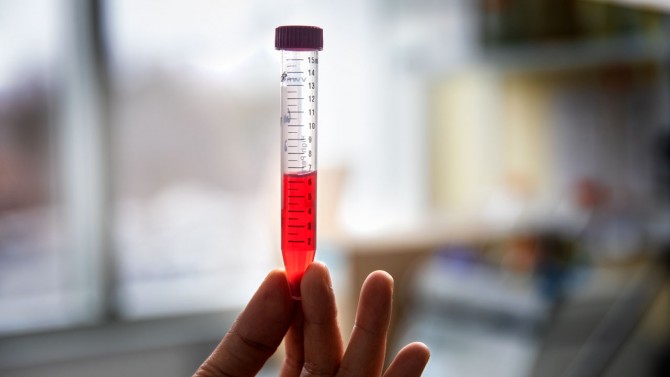
Alireza Abbaspourrad, right, and Detlef Smilgies examine a vial of beet juice with an aim to produce a natural red food dye.
We’ve got the beets: Food consumers may see red, naturally
By Blaine Friedlander
Cornell food scientists hunting for a stable, natural red food coloring to replace artificial dyes have unlocked a secret: Use beet extract and pair it with a starchy partner, according to research published Feb. 8 in the journal Food Hydrocolloids.
“Many processed foods in the United States – like fruit jams, candy, snacks and beverages – contain red dyes,” said senior author Alireza Abbaspourrad, the Yongkeun Joh Assistant Professor of Food Chemistry and Ingredient Technology. “Through other scientific studies, some artificial dyes are implicated in health problems, such as attention deficits and allergies in children.”
To replace the artificial dyes, the food scientists looked to improve the effectiveness of many naturally available dyes, such as the red betalain pigments found in beet extracts. On their own, these natural pigments can discolor after only a few days, and keeping them shelf-stable has been an industry problem.
This research points to a solution: The scientists have found that the natural red color improves in stability after beet extract is attached to a substrate of negatively charged polysaccharide (a long chain of sugar molecules), such as xanthan gum or alginate.
To accomplish that, food science met physics.
Co-lead authors Meghan Marchuk, MPS ’18, and Michael J. Selig ’00, M.S. ’04, a former postdoctoral researcher in Abbaspourrad’s lab who is now an assistant professor of chemistry at Keystone College, worked with Detlef M. Smilgies, a staff scientist at the Cornell High Energy Synchrotron Source (CHESS) to use Cornell’s Quartz Crystal Microbalance with Dissipation (QCM-D) instrument to measure assess the beet extract’s adhesion to the alginate, xanthan gum or other potential substrates.
When Marchuk, Selig and Smilgies tried washing the red color out from potential substrates, they found, using QCM-D, that the beet extract remained attached – like chemical Velcro – to the alginate and xanthan gum’s chemical chains, preserving the red hue.
The QCM-D results indicated that the xanthan gum and alginate substrates bound the pigment quite well, while other substrates, such as gum arabic and beet pectin, retain less beet extract and allow the red dye molecules to rinse away when washed.
Alginate and xantham gum are natural food ingredients based on plant extracts and are used as thickeners in the food industry.
Abbaspourrad indicated that this research introduces a new way to enhance the stability of natural food colors. “This may lead to a replacement of artificial food colors with their natural counterparts on a large scale in the food industry,” he said.
Other contributors to “Mechanistic Investigation Via QCM-D Into the Color Stability Imparted to Betacyanins by the Presence of Food Grade Anionic Polysaccharides,” were former postdoctoral researcher Giovanna Celli and research support specialist Peter Lawrence, both from the Department of Food Science.
The research was supported by the Department of Food Science in the College of Agriculture and Life Sciences. CHESS is supported by the National Science Foundation.
Media Contact
Get Cornell news delivered right to your inbox.
Subscribe

